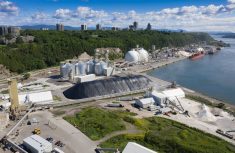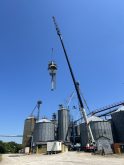A soy-based dust suppressant developed by researchers at North Dakota State University (NDSU) is now being commercialized and brought to market in North America.
It is sprayed onto dusty areas like gravel roads, mining operations and parking lots, but since it’s biodegradable and environmentally friendly, it could also be used on agricultural operations.
Why it matters: The soybean industry is always seeking new uses for soybeans in both industrial and food applications to create market opportunities that help boost profitability for growers.
Read Also

Ontario’s agri-food sector sets sights on future with Agri-Food 2050 initiative
The first-ever Agri Food 2050, a one-day industry event dedicated to envisioning the future of food and farming in Ontario,…
The product stemmed from a need to control heavy dust from truck traffic on gravel roads into and out of the Bakken oil patch in North Dakota. James Bahr, senior research engineer at the NDSU Centre for Nanoscale Science and Engineering, had previously been working with chemists at NDSU to develop new products like paints, polymers and surfactants using soy.
About five years ago, he began combining glycerin, a byproduct of biodiesel manufacturing, with soybean oil to make a dust suppressant. Early results were promising when compared to calcium chloride, the most commonly used dust control product, so Bahr moved his innovation to on-road testing.
Again, results were positive with little dust generation after three months relative to calcium chloride control — and Bahr noticed an interesting secondary benefit too.
“In the road test, we noticed the material could also rejuvenate the reclaimed asphalt pavement present in the gravel road surface. It regenerates the binder and lets it set up again,” Bahr says, adding that discarded road waste and recycled asphalt shingles are often spread onto gravel roads to reduce dust and improve road stability.
His work caught the attention of BioBlend, a U.S. manufacturer of high performance, bio-based lubricants who partnered with NDSU in January to bring the product to market. The company is now using the product across different regions in the U.S. and monitoring its performance in different environments and on different substrates.
If it takes off, the opportunity could be significant for soybean growers.
“The dust control market is quite large. There are over 400,000 miles of gravel road in the U.S. alone that are treated and 80 per cent of that treatment is chloride-based,” says Todd Allison, regional business manager with BioBlend. “If we treated 10 per cent (of those roads), that is 27 million bushels of soybeans — and there are some very large numbers of calcium and magnesium chloride applied in Northern Ontario as well, for example.”

Stockpiles at manufacturing facilities — quarries, fertilizer, or coal mining for example – also suffer from airborne dust problems and could be another large market, he adds.
Those benefits wouldn’t just be limited to U.S. growers given the North American nature of the soybean industry. That’s according to Rob Roe, BioBased Business Development Consultant with Omni Tech International, a U.S.-based consultancy focused on renewable resource development and commercialization of biobased products.
“There is nothing to distinguish a bean grown in Essex or Kent from one grown in Michigan; they move across the border and the processors don’t distinguish,” Roe says.
“If we help create a demand for another (soy) polyol or another polymer or lubricant, the American market is so large for all these products that in the aggregate it will benefit all soy growers in North America. The more markets and applications, the more diverse your marketplace and it’s a way of de-risking and creating incremental demand,” he adds.
Roe was previously the long-time director of Bioproduct Commercialization with Oilseed Innovation Partners in Guelph. The organization wound down operations in 2019 after the provincial government ended its funding, and according to Roe, all market development for downstream oilseed-based products is now happening south of the border.
BioBlend hopes to be in full production by next spring, although Allison notes that glycerin is currently in tight supply because it is also used in hand sanitizer production, which may delay their rollout timelines.
Research and development of the product has been supported by the United Soybean Board, North Dakota Soybean Council and North Dakota Department of Commerce.














